 Home
Home Up
Up Search
Search Mail
Mail
NEW
Newgrange roof box
It is well known that Newgrange has a roof box, through which the
winter solstice sun light penetrates up to the chamber of Newgrange.
This window, through which the sun shines on the chamber floor, is
at present times trapezium formed because the light is blocked by
the orthostats R21 and L20, which are leaning towards each other.
These orthostats were not repositioned due to uncertainty on
structural issues.
Former sky window
Looking at the information on hand, the azimuth and apparent altitude of this former
sky window is determined here:
- O'Kelly states that the sun is visible on the chamber floor
from 08:58 until 09:15 BST on Dec. 21st, 1969 (page
123 until 124 of Newgrange).
- Patrick J. states that the azimuth of the sun can vary between
133° 42' and 138° 24' and the apparent altitude
between 51' and 2°40' (Midwinter sunrise at Newgrange,
Nature, 249, 1974, pp 517-519).
- Ray T.P. states that the azimuth of the sun can vary between
133° 49' and 137° 29' and the apparent altitude
between 55' and 2°11' (The winter solstice phenomenon at Newgrange,
Ireland: accident or design?, Nature, 337, 1989, pp 343 -
345).
Remark: The max. apparent altitude of
2°11' is too small (also compared with the report of O'Kelly
[1982] and Frank Prendergast and
Tom Ray [pers. comm., 2001]).
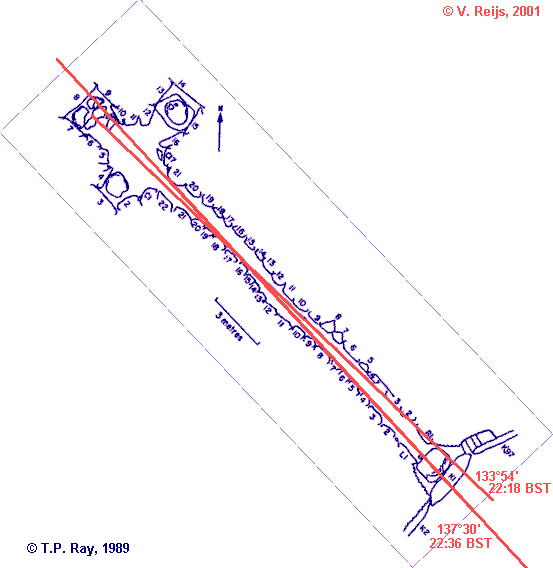
Using the sky window determined by Ray [1989] and using the max.
apparent altitude of 2°40' from Patrick [1974], the sun would
come into the chamber appr. some 48 days (24 days before and after
winter solstice day):
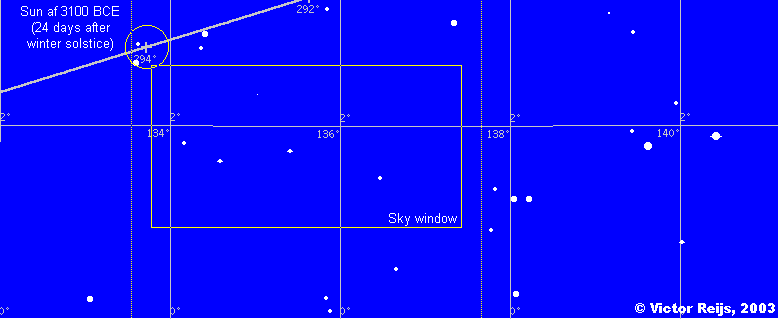
Sun location on Febr. 6th, 3101 BCE (Julian
calendar)
Present day sky window
Information on the present day sky window can be deducted from the
above ideas of the former sky window and the following observation:
- Martin Brennan states that the first sunlight is on the
chamber floor 11 days before and after winter solstice day (page
80 of The stars and the stones).
The following trapezium (or triangular?) formed sky window
(determined by roof box and the leaning in orthostats R21 and L20)
is popping up:
- the right down corner of the trapezium window
(133° 42', 0° 55') (azimuth, apparent altitude)
- the right upper corner of the trapezium window
(136° 22', 2° 40') (azimuth, apparent altitude)
- the left upper corner of the trapezium window
(???, 2° 40') (azimuth, apparent altitude)
- the left down corner of the trapezium window
(???, 0° 55') (azimuth, apparent altitude)
More study has to be done to determine the left side of the
trapezium/triangle in more detail.
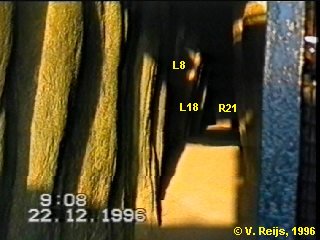
Full moons
Full moons can be used to determine the roof box window in more
detail and it also provides the opportunity to simulate the sun
light 5000 years ago. Remember that the below mentioned dates will
only be valid for the region around Newgrange and rise time. Other
conditions (other place or set time) need to be calculated with a
planetarium program (like Skymap). This is due to fast moving moon
on its path.
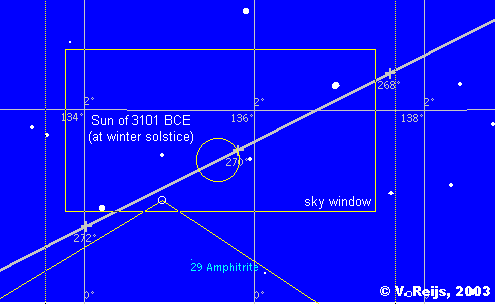
Sun at winter solstice 3101 BCE, Gregorian calendar
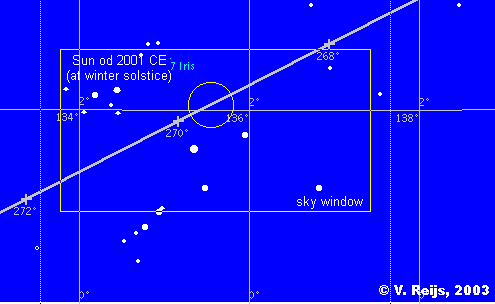
Sun at winter solstice 2001 CE
Full moon risings in the coming years (2001 until 2020) that will
cross the sky window are determined with JPL
ephemeris.
- July 5th,
2001, 22:18 - 22:36 BST (sun at civil twilight).
The moon has simulated the sun's path of winter solstice day
5000 years ago*.
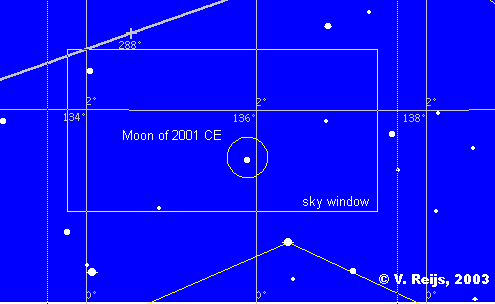
Moon on July 5th, 2001 CE at 22:27 BST
The weather had improved much during the day, but clouds were
still in the way near the horizon:-(. But between 22:24 and
22:32 BST there was a spell: the moon was visible in the sky (video
made beside standing stone GC1 [O 00783 72692] is available).
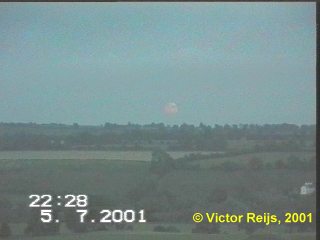
Moon seen from GC1 at 22:28 BST
During this spell the moon light (as was expected
at civil twilight conditions and such a low apparent altitude of
1°38') was faintly experienced inside the chamber. The
in-chamber pictures made by Dúchas don't show the moon in
the roofbox (they were made at the wrong position).
From 22:42 BST onwards the moon became clearly visible in the
sky (not in the chamber, because it was outside the sky window
of the roofbox).
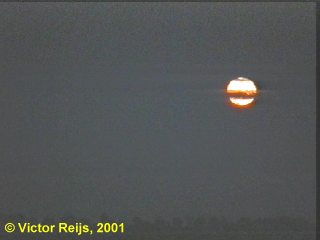
Moon seen from GC1 at 22:44 BST
To be able to witness this from within Newgrange was a great
experience and I am very glad I and others were given this
opportunity. I wish to thank Dúchas (Kathleen O'Keeffe,
Clare Tuffy, Claire Mullen and Sharon Roche), Frank Prendergast
and Michael Ryan for providing this opportunity!
I hope we will be able to repeat this unique sighting on July 14th, 2003. That sighting
will be better, because it will then be nautical twilight at moon rise.
A radio
interview by Áine Ni Chairbre on this event has
been broadcasted by Louth
Meath FM Radio (95.8 MHz) on July 8th, 2001
19:48 - 19:59 BST.
- July 6th, 2001, 23:11 - 23:25 BST (sun at nautical
twilight)
- July 14th, 2003, 23:12 -
23:37 BST (sun at nautical twilight). The moon will simulate
the sun's path of winter solstice day 5000 years ago*. The duration of the expected shadow inside
Newgrange is prognosed in this
section.
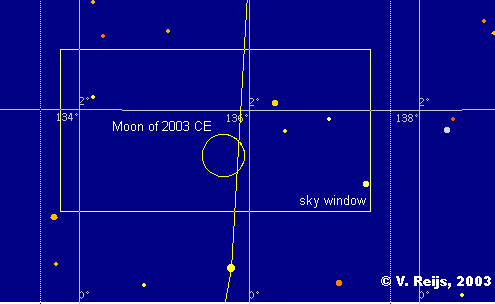
Moon on July 14th, 2003 CE at 23:21 BST
On July 14th, 2003 no moon rise was visible due to
clouds. The first moment part of the the moon was visible was
around 23:43 BST. A picture of the full moon form at 23:47 BST
is below (still a little obscured by clouds and haze):
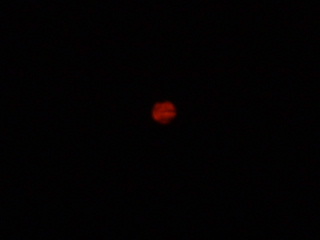
- July 31st, 2004 (sun at civil twilight)
- May 23rd, 2005 (sun at civil twilight)?
- May 13th, 2006 (sun at nautical twilight)?
- May 19th, 2008 (sun at civil twilight)?
- May 9th, 2009 (sun at nautical twilight)?
- July 7th, 2009 (sun at civil twilight)
- May 17th, 2011 (sun at civil twilight)?
- June 6th, 2020 (sun at nautical twilight)
- July 5th, 2020 (sun at civil twilight)
The * full moons in 2001 and
2003 are at the same position as the winter solstice sun was in
3100 BCE (the possible building date of Newgrange)!!!
The ? mean that it is
not known if the moon will shine on the floor of the chamber
(depends on the true dimensions of the sky window)
Twilight conditions at moon rises
The following
definitions exists with regard to twilight conditions:
- full daylight
sun's altitude above 0°
- civil twilight
sun's altitude between 0° and -6°
- nautical twilight
sun's altitude between -6° and -12°
- astronomical twilight
sun's altitude between -12° and -18°
- full darkness
sun's altitude below -18°
One of the drawbacks of moon shadow sightings within Newgrange could
be that the sun is still close to the horizon, and thus no full
darkness. So tests have been done with a mock-up of Newgrange. This
mock-up was made with a appr. 1m long tube and 5 cm in diameter (so
creating a sky window comparable. the size of the roof box). One end
is open and the other end is covered with opaque paper (to be able
to see shadows). The side of the opaque paper also had a black vale,
so that while watching the shadows on this paper, no other light was
on it, thus creating a kind of dark chamber;-).
There are two differences between this experiment and the actual
location: in the experiment the moon light is perpendicular
to the opaque paper, while in Newgrange the moon light is
only a few degrees over the gravel on the ground.
Sightings were done on two full moon rise dates:
- July 16th, 2000 (civil twilight)
- 22:08 BST middle of moon at 1° 27'
no real shadow to be seen in the chamber, just a hint
- 22:10 BST middle of moon at 1° 39'
some shadow to be seen in the chamber, but difficult to
make this out
- 22:15 BST middle of moon at 2° 10'
a good shadow to be seen
- July 17th, 2000 (nautical twilight)
- 22:41 BST middle of moon at 1° 24'
some shadow to be seen in the chamber
- 22:46 BST middle of moon at 1° 55'
a good shadow to be seen
- 22:52 BST middle of moon at 2° 30'
a good shadow to be seen
Certainly at nautical twilight, shadows can be seen . At civil
twilight perhaps not the start can be seen, but at least the end of
the phenomena is visible.
Some proof that full moon (98%) can be photographed when sun is at
nautical-astronomical twilight; look in Brennan [1983, page 99]. This provides a
picture of the moon light on stone 6 of Cairn T on April 1st,
1980, around 20:10 GMT.
The visibility of shadows can also be determined with a model.
Disclaimer and Copyright
 Home
Home Up
Up Search
Search Mail
Mail
Major content related changes: July 6, 2001









